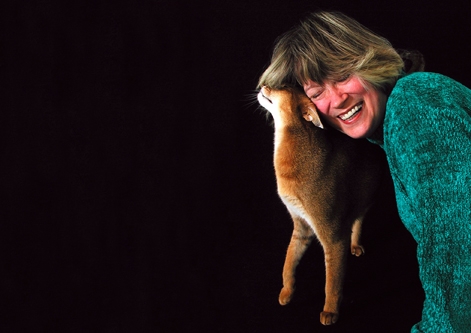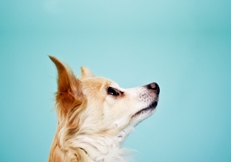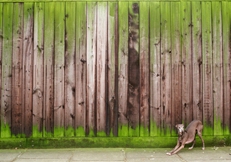
‹‹Helmi Flick
Register FREE
Get more, like the ability to view images without watermarks
...sorry, you don't get the cute kittens.
About Helmi Flick
A late start . . .
When Helmi Flick finally discovered what she was meant to do in life she was at an age when most people are counting down to retirement. After working for more than 30 years in administrative jobs in advertising, law, health care and technology, Helmi was able to do what most people only dream of.
“It wasn't much of a living for the first few years,” Helmi says, “And, at age 55, I certainly got a late start, but neither of these things mattered. I was having so much fun photographing cats I would have done it for free.”
Such was Helmi's enthusiasm that when she launched her career as a professional cat photographer at a cat show in 2000, she did so without any formal training in photography and without the slightest fear that the venture would be anything but successful.
. . . with the “wrong” equipment?
“I was the only one shooting with a digital camera. Everyone else was still using film, as they had been since they started out, but that wasn't for me. I knew from the days when I used to shoot our own cats with a film camera, that I never would have attempted this career if digital cameras hadn't come along. I wasn't that good before my first digital, and I wasn't getting any better without the instant feedback of that great learning tool. Digital photography enabled me to see my mistakes immediately and learn from them.”
“The second way I did things differently from my cat photographer colleagues was that I was virtually the only one who did not work alone. This is another instance in which I would not attempt cat photography – even now – if I had to do it all myself. I certainly respect those who do work by themselves, but I know I could not get the quality of images that we do if I had to work without my husband Ken doing the wrangling. We’re a team.”
An illuminating difference
After Helmi and Ken had been shooting cats professionally for a while, and paying more attention to how other cat photographers were working, it became clear that there were two more differences in the way they worked, compared to everyone else.
“From the beginning,” Ken says, “Our approach to lighting was a very traditional one. We used the classic four-light setup – key light, fill light, hair or fringe light and background light -- that studio photographers have always used when shooting glamor models as well as celebrity and executive portraits.
Our philosophy is that we want to make every cat we photograph look and feel like a celebrity, and beyond coaxing the cat into a series of ideal poses on an appropriate background color, flattering light is the key element. It’s another advantage of Helmi and I working as a team and almost always driving to shows: we have more cargo room in our minivan to transport the extra lighting gear and we have the two of us to set it all up.”
Encouraging new talent
For the first five years they were in business, Helmi and Ken were the only cat photographers using their four-light setup, and even today, many of the old timers who started with film cameras and work alone still use the simpler two-light setup, but in recent years, the world of cat shows began to see a number of new faces enter the small niche of cat photography. This new breed who, like the Flicks, began their careers with digital cameras, were more likely to adopt the more ambitious lighting system that Ken and Helmi were using.
A few years ago, it was easy to look through a cat magazine, which usually featured the work of several photographers, and immediately tell, without looking for the photo credits, which images were Helmi’s. “Today, it’s not quite so easy to tell our images from those of a few other cat photographers. For the most part, these others whose work resembles ours, are those people who we have either mentored directly or who were influenced by our look and sought to emulate it – and that’s a good thing. It’s flattering to have influenced new talent and we applaud their success. We welcome the competition because it motivates us to try new ways to improve our own work. And those cat owners and breeders who need good pictures of their cats are now the richer for having more talented photographers from whom to choose.”
Getting good reviews
Even today, 11 years after Helmi began shooting cats professionally, there is still one difference in the way she works that sets her apart from virtually every other cat photographer in the business. It is also her way of getting closer to her customers, to learn what they want from a photographer and to be certain she is delivering it. At the end of each photo session, Helmi makes the time to sit with her customers and review every image.
“The time I spend with my customers, reviewing the images I’ve captured, is time I could be using to shoot the next cat, so it does limit the number of cats and customers I can handle during a show, compared to photographers who do not do a review, but I wouldn’t think of giving it up. It may be my favorite part of the photo session. I don’t stop shooting until I feel that we have captured every good pose the cat will give us but, because I guarantee my work, it is important to know that my customers feel the same way and are delighted with the images I show them. It's the way I learn about what I can do better.
From my very first show – when I couldn't tell a Maine Coon from a Norwegian – it was also how I learned the differences between breeds and the special types of poses that the owners preferred.”
Helmi and Ken live in Dallas, Texas, with their four cats: two Maine Coons and two British Shorthairs. They have a small photo studio in their home but capture most of their cat images at cat shows around the United States and occasionally abroad.
Helmi's images have been published in books and magazines on every continent, except Antarctica. She is the only cat photographer in the U.S. to have been profiled by a major photography magazine Popular Photography, the most widely-read photography magazine in the world.


